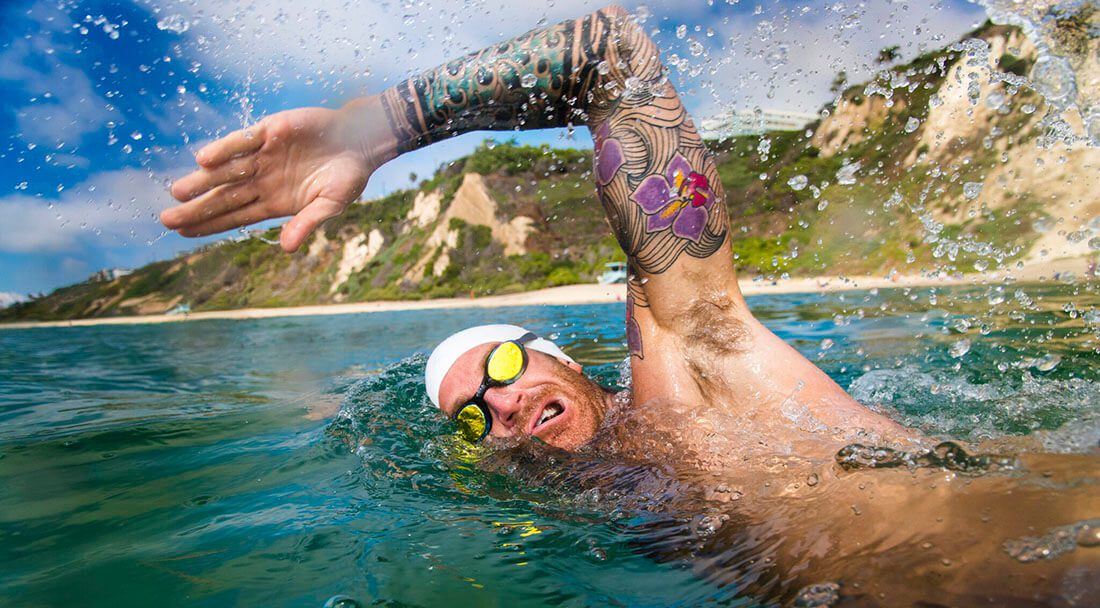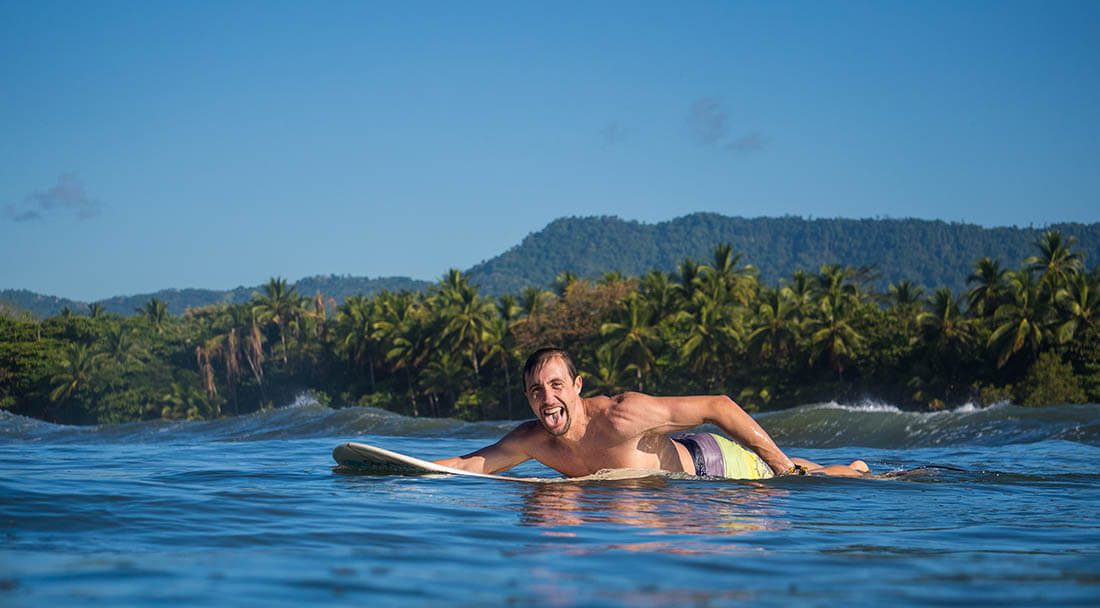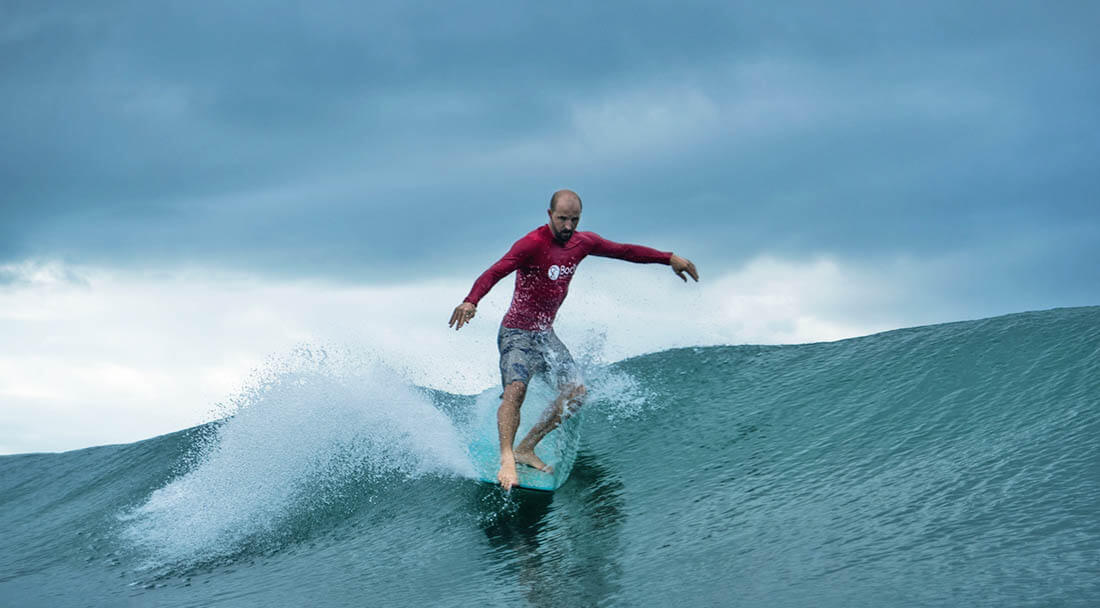Here at Bodhi Surf + Yoga, one of the most common things we hear from our beginner surf students is:
“I didn’t know surfing was going to be so exhausting! I need to exercise more.”
Yes, this is true! Surfing demands a high level of fitness in a variety of different capacities — surf fitness can be slightly different than regular fitness! The more surf fitness trainings you perform on dry land, the longer you’ll be able to stay out in the ocean. That will mean more waves caught and more fun.

7 Day Surf Camp
Week long, set-date, surf vacations that invite you to learn the art of surfing while learning about Mother Ocean, engaging with the community, and awakening the inner surfer.
Learn MoreBut what about the students who come to Bodhi Surf + Yoga already in great shape?
At the end of their first two-hour surf lesson, they end up saying something similar:
“I thought I was in good shape, but…”.
This is because surfing requires a very specific kind of fitness. We will cover this in great detail throughout the rest of this post.
If you are more of a visual learner, don’t worry! We have included many surf training videos — on shoulder strength, core strength, balance, and overall fitness for surfers.
And if you are a gear junkie, stay tuned for some great training equipment recommendations as well!
Why does surfing require good fitness?
As a former college athlete, competitive crossfitter, and ocean lifeguard, I like to think I’m in pretty darn good shape. But even so, I’ve been humbled by the ocean many times, especially when I was first learning how to surf.
I can still vividly remember the first time I tried to speed-paddle a shortboard out past the surf zone in big waves.
Needless to say, the journey didn’t go as planned. I had to turn my board around before making it all the way out to the lineup. My shoulders were burning so bad, I simply could not paddle any longer.
Surfing is mostly paddling
In fact, it’s quite strange that we call surfing surfing and not paddling, considering that we surfers spend the vast majority of our time paddling the surfboard around rather than standing up on it.
According to a study of professional New Zealand surfers competing in 20-minute heats, the competitive surfers were paddling for waves over 50 percent of the time, while spending less than 10 percent of the surf session actually riding waves.
The study also found that the professional Kiwi surfers maintained heart rates above 120 beats per minute for more than 80 percent of the surf session. This is a considerable level of aerobic endurance.
As it turns out, paddling is exactly what makes surfing so physically demanding. For that reason, every surfer should start by developing a high level of both aerobic and anaerobic fitness.
Aerobic vs. anaerobic fitness
Now what do I mean by aerobic and anaerobic fitness?
- Think of aerobic conditioning (abundant oxygen) as a nice, easy jogging pace that you can maintain over a long period of time.
- Anaerobic conditioning (absence of oxygen), on the other hand, is more like a sprint — a high intensity pace that elevates your heart rate and forces you to breathe rapidly.
Surfing, or paddling, requires both types of conditioning. Sometimes you will be jogging over long intervals and sometimes you will be sprinting in short bursts:
“Surfing involves intermittent high-intensity bouts of all-out paddling intercalated with relatively short recovery periods and repeated bouts of low-intensity paddling, incorporating intermittent breath holding.” – The Physiological Demands of Competitive Surfing
Therefore, if you want to improve your surf fitness, then you must incorporate both high and low-intensity training methods, otherwise known as interval training.

How to train for surfing
Interval swim training
Swimming is one of the best methods for training both your aerobic endurance and anaerobic threshold for surfing.
Swimming, like surfing, takes place in an aquatic environment where minimal oxygen is available to the body. This forces the swimmer to uptake and store oxygen in the most efficient way possible.
Humans are born with something called the mammalian dive reflex. This is an innate physiological adaptation that helps us conserve oxygen when submerged underwater!
“When a human holds their breath and submerges in water, the face and nose become wet which in turn causes bradycardia, apnea, and increased peripheral vascular resistance; these three main physiologic changes are collectively referred to as the diving reflex. The cause of increased peripheral resistance is thought to redistribute blood to the vital organs while limiting oxygen consumption by non-essential muscle groups.” – Physiology, Diving Reflex
So if you want to train your body to redistribute blood to the vital organs while limiting oxygen consumption by non-essential muscle groups, then exercising in water (aka swimming) is a great method of surf training.
But, as we discussed earlier, pool swim laps should be broken into intervals of jogging and sprinting so that you exercise both your aerobic (or cardiovascular) and anaerobic capacities.
Each pool swim workout should include the following intervals:
- Warmup set: 200m freestyle, 30 secs rest, 200m freestyle (aerobic pace, focus on technique)
- Distance set: 400m freestyle, 30 secs rest, 200m freestyle, 30 secs rest, 200m freestyle (aerobic pace)
- Speed set: 10 rounds of 25m freestyle, 30 secs rest (max effort)
- Threshold set: five mins freestyle (fastest pace that you can maintain over long interval)
- Cooldown set: 200m freestyle (aerobic pace)
Here is a great introductory swim workout video that will help you conceptualize the above intervals: How To Plan A Swim Workout.
Join an open water swimming group
Swimming laps in a pool is probably the easiest and most consistent method of exercise for surf training. And the best part about swimming in a pool is that you can do it just about anywhere!
However, if you live near the coast, swimming in the ocean is the ideal place to improve your surf conditioning.
When I was training to become an Ocean Lifeguard for the City of San Diego, I joined an open water swimming group called One With The Ocean that offers weekly hour-long swim training sessions.
After training with this group one to two times per week for several months, I noticed a dramatic improvement in my swimming ability and surf conditioning!
Not only did my swim technique improve, but I was also able to swim (and paddle my surfboard) for much longer intervals without getting tired.
These hour-long group swim sessions include many different forms of exercise, such as running, long-distance swimming, sprint-swimming, and even bodysurfing — all great methods of improving your fitness as a surfer.
One With The Ocean currently has 17 chapters throughout North America, including San Francisco, Santa Barbara, Los Angeles, San Diego, Hawaii, Texas, and Boston.
Now that we’ve covered what type of fitness surfing requires, let’s dive a bit deeper into what specific muscle groups we should focus on for surf training.

Surfing exercises for paddling
How to develop shoulder strength and mobility
During a typical two-hour surf session, you may only spend a minute or two total up on your feet! The rest of that time is spent paddling through the impact zone and into position for the next rideable wave.
And unlike swimming or boogie boarding, you are unable to kick your legs to help you move across the water. Only the upper body muscles are used to propel the board forward.
Therefore, it is important to build strength and mobility to ensure you are recruiting the proper upper body muscles to improve power while paddling.
The most important muscles to strengthen for surfing are located in the posterior shoulder (scapula) and upper back, including:
- Rotator cuffs
- Scapula stabilizers
- Latissimus dorsi
- Trapezius
Use high-rep band exercises for shoulder injury prevention
As a former Division I baseball player at the University of San Diego, I used high-repetition band exercises to improve my shoulder strength, mobility, power, and endurance.
Interestingly enough, the most common injury in baseball is also the most common injury in surfing: rotator cuff strain.
The best way to prevent straining the muscles of the rotator cuff is to develop posterior shoulder strength by training the scapula stabilizers using shoulder band exercises.
If you are looking for shoulder strengthening bands, then I highly recommend Crossover Symmetry. I used these bands daily to improve my throwing power and keep my shoulders healthy throughout my college baseball playing career, and have continued to use them to strengthen my shoulders for surfing.
But all you really need is a simple resistance band and some functional high-rep exercises to warm up your upper body before your next surf session.
Here is a simple five-minute video that will guide you through my personal shoulder warm-up routine: Strengthening Arms + Shoulders for Surfing.
Shoulder band training orutine (three rounds of 20-30 reps)
- Reverse flys
- Bear hugs
- 90/90s
- Punches
- Archers
- Floss
- Single-arm pulls
- Single-arm external rotation
How to build core strength for paddling and popping up
Why is developing core strength important for surfing?
Developing core strength for surfing is important for two reasons:
- A strong core allows you to maintain a healthy paddling posture that will protect your spine and shoulders from injury.
The stronger the core, the easier it is to popup from the prone position to the standing position. - If you are someone who works from a desk for a living, then your spine is likely in a compromised (rounded and compressed) position for most of the day. Thus, it will be quite the challenge to maintain a healthy body posture when paddling.
Many surfers end up getting injured because they lack proper mobility in the spine, which is in a constant state of extension while paddling.
Strong abdominal and lower back muscles help us maintain this challenging posture over extended periods of time without slouching, and allow us to recruit the proper upper body muscles for paddling with power.
Furthermore, a strong core improves our athletic capacity and helps us stand to our feet efficiently.
Beginner surfers, for example, tend to rely too heavily on upper body strength when popping up to their surf stance.
Yes, developing a strong upper body is critical for any surfer.
However, popping up is more about creating leverage than using strength. This crucial body movement depends on strong abdominal muscles and good body mechanics (technique over strength).
Practice yoga for core strength and spinal mobility
Yoga is hands down the most effective exercise to improve core strength, body posture, spinal mobility, joint health, and body mechanics for surfing.
The yoga asanas are geared toward aligning the body and improving posture, which help maintain the spine’s natural curvature and reduce back pain — a common byproduct of surfing.
If you are curious about the myriad benefits of yoga for surfers, then check out this blog post: The Benefits of Yoga for New Surfers.
Also, check out the above seven-minute video, Strengthening Your Core for Surfing, which guides landlocked surfers through a series of stretches, mobility drills, and exercises to improve spinal mobility and core strength for paddling and popping up.
Four essential yoga poses for beginner surfers
- Cobra pose: This particular asana is a great way to stretch out the muscles of your chest, shoulders, and abdominals. You will also use this pose to keep the nose of your surfboard from diving underwater when catching a wave in the prone position.
- Child’s pose: This relaxing position is a great way to open up your posterior chain and get a deep stretch in your hips, quads, and ankles. After successfully riding a wave to the beach in the prone position, you can use child’s pose to bring all of your weight to the back of your surfboard and come to a controlled stop.
- Plank: Less of a stretch and more of a muscle-builder, plank pose will improve your core strength and recruit more muscle mass to your arms and shoulders. You will have to use plank pose while paddling your surfboard through oncoming whitewater waves in order to make it out to the lineup. Furthermore, being able to push up into a plank will undoubtedly improve your ability to “pop-up” when standing to your feet on a surfboard.
- Warrior II: Favored as a deep hip and groin opener, this pose is also great for improving your balance on a surfboard. Although Warrior II is not exactly the same stance you will maintain while surfing, it is very similar, and can help you get accustomed to standing in that position.
How to improve balance for riding the wave
Okay, now that we’ve covered proper strength and endurance techniques for paddling and popping up, it’s time for the fun part: riding the wave!
Standing up on a surfboard (and remaining on your feet for as long as possible) is undoubtedly the most enjoyable aspect of surfing. But you must maintain good balance and coordination to maximize this pleasure and improve your surfing.
Improving your balance for surfing means strengthening your legs and abdominal muscles, and coordinating different muscle groups to work together.
The following eight-minute video, Mastering Balance for Surfing, is a collection of single leg balance drills, double leg strength exercises, pushup position holds, balance ball exercises, and dynamic movements — all geared toward promoting better speed, balance, and overall athletic ability.
Surf training equipment: Tools to improve your balance
In addition to practicing the many training exercises displayed in the video above, there are two pieces of fitness equipment that will help improve your balance quickly:
1. Gibbon slackline
Slacklining offers a fun combination of exercise, play, and meditation. Although learning how to slackline can be challenging at first, it is something that you will want to try over and over again until you are able to walk the entire length of the line without falling!
I personally use a slackline to improve my balance on one leg, which helps when walking to and from the nose on a longboard.
2. Indo balance board
The Indo balance board was specifically designed to help board-riders of all kinds improve their athletic capacity in a safe and stationary environment, but was initially geared toward surfers:
“The INDO BOARD was originally developed as an indoor surfing trainer to help surfers by providing balance training and core exercises that not only help beginner surfers learn to surf, but also provide advanced surfers with a balance board allowing them to perform surf workouts and advanced surf exercises anytime and anywhere.”

Weekly surf fitness training for your next surf trip
Okay, now it’s time to apply what you’ve learned about surf fitness into a simple, cohesive training program!
Here is a sample weekly training program that can be modified and repeated over many weeks to prepare your body and improve your fitness for your next surf trip:
- First day: 10 mins Indo balance board, 30 mins yoga
- Second day: 10 mins Crossover Symmetry band routine, 30 mins pool swim
- Third day: 40 mins Gibbon slackline practice
- Fourth day: Recovery Day
- Fifth day: 10 mins Indo balance board, 30 mins yoga
- Sixth day: 10 mins Crossover Symmetry band routine, 30 mins pool swim
- Seventh day: 40 mins Gibbon slackline practice
Each daily workout should take no longer than 40 minutes and can be performed just about anywhere in the world!
Get Step-by-Step Surf Lessons in Your Inbox
Learn to Catch Waves with our free 5-day email series from one of our lead surf instructors here at Bodhi Surf + Yoga.
Change the heading on the Separator tab ->
Search
Get Step-by-Step Surf Lessons in Your Inbox
Learn to Catch Waves with our free 5-day email series from one of our lead surf instructors here at Bodhi Surf + Yoga.
Change the heading on the Separator tab ->
Most Read Blogs
What is the Meaning of Anjali Mudra?
May 27, 2020
Fitness for Surfers: Workouts, Exercises & Training
February 10, 2022
The Best Places to Eat in Uvita, Costa Rica
May 19, 2022
How to Get From SJO to Costa Ballena, Costa Rica
May 31, 2018
Change the heading on the Separator tab ->
Categories
Categories
- Bodysurfing (5)
- Food (7)
- Responsible Business (6)
- Surfing (63)
- Travel (65)
- Yoga (41)
Change the heading on the Separator tab ->
Newsletter
Thanks for subscribing! Please check your email for further instructions.
Change the heading on the Separator tab ->
Follow Us
Bodhi Surf + Yoga
Change the heading on the Separator tab ->
Read more
5 Advanced PNF Stretches for Surfing
Words by Guest Post
Like in any sport, surfing requires exceptional mobility and range of motion in the joints. Stretching is a great tool to gain mobility for those eye-catching maneuvers or a post-session recovery routine….
A Typical Day: Bodhi Sessions 7 Day Surf + Yoga Camp
Words by George Frost
If you’re looking for a surfing and yoga experience that inspires, educates, and empowers – look no further! Our Bodhi Sessions 7 Day Surf + Yoga Camp is designed to help you…
A Typical Day: Bodhi Sessions 14 Day Surf + Yoga Camp
Words by George Frost
If you’re looking for a surfing and yoga experience that inspires, educates, and empowers – look no further! Our Bodhi Sessions 14 Day Surf + Yoga Camp is designed to help you…



